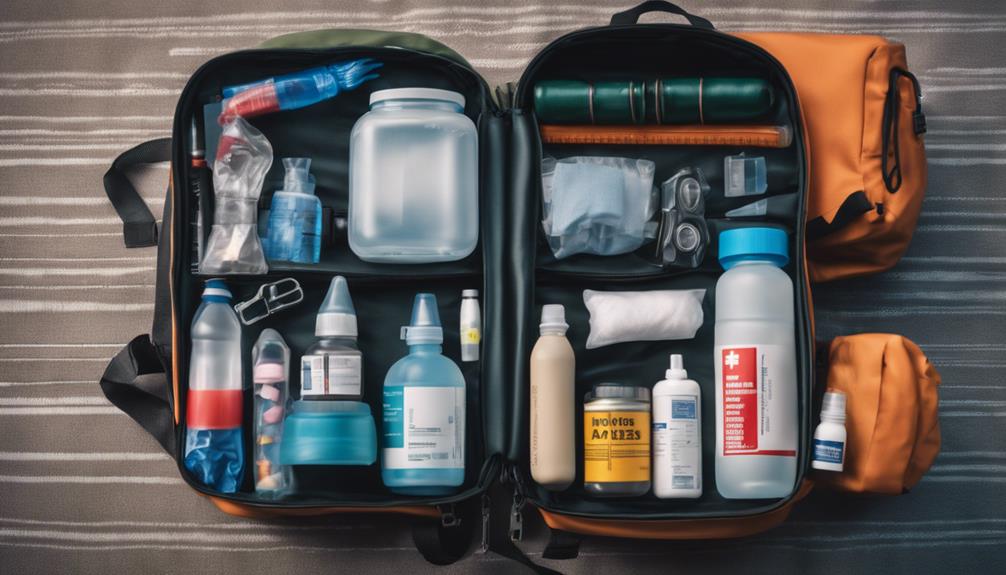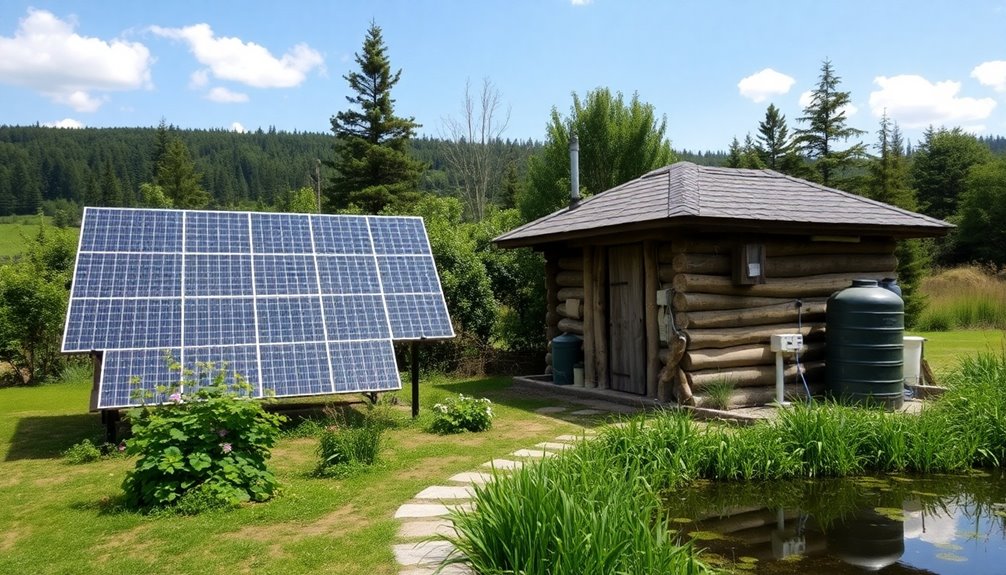To signal for help in the wilderness, carry visual tools like signaling mirrors, bright fabrics, and ground symbols in open areas. Use whistles, loud bangs, or SOS calls to draw attention with sound. Electronic devices such as satellite phones or PLBs improve communication. Place large symbols on high ground, update signals regularly, and combine fire or smoke signals with visual cues. Staying strategic about timing and location boosts your rescue chances—continue to explore better ways to attract help.
Key Takeaways
- Use large, high-visibility ground symbols like “HELP” or arrows in open areas for aerial recognition.
- Signal visually with reflective materials, bright fabrics, and fire or smoke displays during day and night.
- Employ auditory signals such as whistles with short blasts and loud noises to attract distant rescuers.
- Position signals on high ground or clearings, regularly updating them to maintain visibility.
- Utilize electronic devices like satellite phones and PLBs, ensuring they are charged and functioning properly.
Essential Signaling Equipment and Preparation

Having the right signaling equipment and being prepared can make all the difference in an emergency. Pack a compact signal mirror to catch the attention of rescuers from a distance, and include signaling devices like a whistle for auditory signals. Reflective materials, such as emergency blankets or brightly colored cloths, boost your visibility in low-light conditions. Practice using your signaling devices regularly so you can deploy them quickly when needed. Fire-starting tools like waterproof matches, lighters, or ferro rods are essential for creating smoke and light signals, especially at night. Also, carry a reliable flashlight and a map with a compass to identify ideal locations for signaling. Being well-prepared with these tools increases your chances of rescue and keeps you ready for any situation.
Visual Signaling Techniques for Rescue

To improve your chances of rescue, create large ground symbols that are at least 10 to 20 feet long and easily recognizable from the air. Use bright, contrasting materials like aluminum foil or orange plastic bags to make your markings stand out against natural surroundings. Position these symbols in open, unobstructed areas for maximum visibility from searchers and aircraft.
Ground Symbols Visibility
Ground symbols are most effective when they are large, simple, and highly visible from the air. To maximize their visibility, use ground symbols at least 10 feet long, crafted with contrasting materials like rocks, logs, or foliage. Placing these symbols in open areas ensures they are unobstructed and easy to spot. Incorporate bright, reflective materials or vivid fabrics to outline your signals, increasing contrast and visibility in daylight or low-light conditions. Adding directional arrows or pathways can also help guide rescuers toward your location. Regularly maintain and update the symbols, especially after weather events or disturbances, to keep them effective. Ensuring proper watering of ground symbols with water or reflective materials can enhance their visibility in various conditions. Using ground symbols that are consistent and standardized can improve recognition by rescue teams. Additionally, understanding the importance of contrast ratio in visual signaling can make your symbols more distinguishable from the environment. Proper lighting techniques, such as using natural or artificial light sources, can further increase visibility during dawn, dusk, or overcast conditions. Employing reflective materials or paints specifically designed for high visibility can also significantly improve the chances of being noticed from above. Clear, well-placed ground symbols substantially improve your chances of being seen and rescued from the air.
Large, Recognizable Markings
Large, recognizable markings are essential for catching the attention of rescuers from the air. They guarantee ground-to-air signals are visible from miles away, increasing your chances of rescue. Use bold symbols like “HELP,” large “X” marks, or directional arrows, all at least 10 to 20 feet long. Contrast materials such as rocks, logs, or brightly colored fabric help your signals stand out against natural surroundings. Place these ground-to-air signals in open, unobstructed areas near your shelter, making sure they’re large enough and strategically positioned. Regularly maintain your markings, keeping them clear and visible. These large, recognizable markings can make the difference between being overlooked and being rescued quickly. Proper planning and recognition of signal visibility are crucial for successful rescue efforts. Additionally, understanding how to shift gears smoothly on your bike can help you navigate difficult terrain more efficiently during an emergency, ensuring you can reach help more quickly. Being familiar with survival techniques can also improve your chances of staying safe until rescue arrives. Remember that maintenance of signaling equipment, such as ensuring your markers remain visible and intact, is vital for ongoing rescue efforts.
Auditory Signals to Attract Attention

Auditory signals are a crucial way to attract attention in the wilderness, especially when visual cues are limited. Your goal is to create loud, unmistakable noise that signals distress and draws rescue efforts. Using a whistle is highly effective since its sharp blasts can be heard over a mile away, especially when blown in three short bursts—the universal distress signal. Repeating these bursts every few minutes increases your chances of being noticed. You can also generate noise by banging on hollow logs or striking rocks, which produces long-distance sound that cuts through ambient wilderness sounds. Vocal calls like shouting are less effective due to limited range and quick exhaustion. Rhythmic sounds, such as Morse code SOS, help rescuers recognize your distress more efficiently. Incorporating sound frequency considerations, such as using higher-pitched signals, can improve the audibility of your signals in dense environments. Additionally, understanding acoustic properties can help you optimize your sound signals for maximum reach and detection. Using sound amplification techniques, like placing your mouth close to a hollow object, can further increase the volume and reach of your signals. Employing real-time monitoring techniques enhances your ability to adjust signals based on environmental feedback. Being aware of personality traits, such as resilience and calmness, can also aid in maintaining effective signaling over extended periods.
Using Electronic Devices for Emergency Communication

When you’re in a wilderness emergency, electronic devices like satellite phones and Personal Locator Beacons (PLBs) become essential tools for communication. A satellite phone lets you make direct voice calls from virtually anywhere, even where there’s no cell signal, enabling you to request help immediately. Personal Locator Beacons automatically send an emergency signal with your GPS coordinates when activated, ensuring rescue services can locate you quickly, especially in remote areas. Modern devices often include pre-set messages to relay critical information rapidly. To guarantee these tools work when needed, keep them fully charged, protected from the elements, and practice using them beforehand. Reliable electronic communication can be lifesaving, providing a critical link to rescue teams when every second counts. Additionally, understanding security concerns related to new device standards can help you better protect your personal information during emergencies. Being aware of industry trends can also inform you about the latest advancements in emergency communication technology, potentially offering more reliable solutions. Regularly updating your device firmware and understanding emergency protocols can further enhance your preparedness in critical situations.
Creating Effective Ground-to-Air Signals

To make your ground-to-air signals effective, use contrasting materials like rocks, logs, or bright fabrics to create large, simple symbols visible from a distance. Guarantee your signals are at least 10 to 20 feet long and placed in open, unobstructed areas for maximum visibility. Regularly check and update your markings to keep them clear and noticeable from the air. Incorporating visible water features can also help attract attention from above. Additionally, understanding emotional support can be crucial if you are feeling anxious or overwhelmed in a survival situation, helping you maintain a calm and focused mindset. Being aware of road sign rules can also assist in understanding your environment and making informed decisions if you encounter landmarks or markers along your path. Leveraging security systems for monitoring your location can provide an extra layer of reassurance if you have access to such technology. Familiarizing yourself with top-rated survival gear can further enhance your safety and preparedness in emergency situations.
Use Contrasting Materials
Using contrasting materials is essential for creating ground-to-air signals that catch the eye of searchers and aircraft. You want your ground signals to stand out clearly against natural terrain, so choose materials with high contrast. Imagine bright fabric or colored stones arranged into bold symbols, easily recognizable from above. Reflective materials like emergency blankets or survey tape can reflect sunlight, boosting visibility during daytime. Think of large symbols, at least 10 to 20 feet long, in white on dark ground or black on light surfaces, making them unmistakable. You might also burn petroleum products to produce black smoke against white snow or clouds. Incorporating contrasting materials ensures your signals are visible, clear, and effective in guiding rescuers to your location. Additionally, visual contrast plays a crucial role in making sure your signals are distinguishable from the surrounding environment, increasing the chances of being noticed.
Ensure Size Visibility
Creating ground-to-air signals that are easily visible from above requires careful attention to their size. To maximize visibility, guarantee your ground signals are at least 10 feet long, with larger sizes increasing the chance of rescue. Use contrasting materials such as rocks, logs, or bright fabrics to make your signals stand out against the terrain. Creating simple, large patterns like triangles, Xs, or the letters SOS helps rescuers recognize your signals quickly. Position your ground signals in open, unobstructed areas on high ground to enhance visibility from low-flying rescue aircraft. Regularly maintain and update your signals, especially after weather changes or foot traffic, to keep them clear and effective. Proper sizing and placement are vital for successful rescue efforts.
Choose Open, Unobstructed Areas
Choosing the right location for your ground-to-air signals is essential to guarantee they can be seen from above. You need open, unobstructed areas that maximize visibility for rescue aircraft. Select spots at least 10 to 20 feet long, free from dense trees, bushes, or terrain features that could block the view. Position your ground signals near your shelter or a central point, so they are visible from multiple angles. Use contrasting materials like rocks, logs, or brightly colored fabric to create large, simple symbols that stand out. Regularly maintain and clear your signals to keep them prominent, especially after weather changes. An open, unobstructed space assures your ground signals are clear and easily recognizable, increasing your chances of rescue from above.
Fire and Smoke as Signaling Tools

Fires and smoke are essential signaling tools in wilderness emergencies because they can be seen from great distances, especially at night. A well-built fire arranged in a triangle or line makes a powerful distress signal, while smoke signals are visible during the day. Green vegetation produces white smoke, enhancing daytime visibility, whereas burning petroleum or plastic creates black smoke for night signaling. To maximize effectiveness, place large fires in open areas, avoiding obstructions that limit visibility. Combining fire with smoke signals increases your chances of rescue, as both can be seen from miles away. Always exercise caution: keep fires manageable, safe, and prevent wildfires. Use the following table to visualize the impact of different signaling methods:
| Fire Type | Smoke Color | Visibility Time | Effectiveness |
|---|---|---|---|
| Large fire | White smoke | Day/Night | High |
| Small fire | Black smoke | Night | Moderate |
| Green vegetation | White smoke | Day | Good |
| Petroleum fire | Black smoke | Night | Excellent |
| Line/triangle fire | N/A | Night | Distress signal |
Best Practices for Signal Timing and Placement

To maximize your chances of being rescued, you should carefully time and place your signals where they are most visible to searchers and aircraft. Focus on essential signal timing during daylight for ground markings and at night for fires or flashlights. Proper placement is critical—choose open, high-visibility areas like hilltops, ridges, or clearings that prevent obstructions. Ensure signals are large and simple, with symbols at least 10 to 20 feet long, making them easily distinguishable from the air. Repetition also plays a key role; repeat signals every 5 to 15 minutes to catch the attention of overhead searchers. By combining strategic placement, effective timing, and consistent repetition, you markedly improve your chances of rescue.
- Place signals in open, high-visibility areas like hilltops or ridges
- Use daytime for ground markings, nighttime for fires or flashlights
- Keep signals large, simple, and easily recognizable from above
- Repeat signals regularly to boost visibility
Frequently Asked Questions
How to Signal for Help in the Forest?
When you need to signal for help in the forest, you should create large ground symbols like “V” or “X” using rocks or logs in open areas, making sure they’re visible from the air. Use bright materials such as orange clothing or reflective tape to stand out. Light fires safely in a clear spot to produce smoke or flames, and use sound signals like whistles or shouts, especially from elevated ground, to attract rescuers.
How Do I Signal for Help on a Deserted Island?
Imagine drawing a giant SOS or HELP on the ground with rocks or logs, big enough to catch a plane’s eye. Build signal fires at the highest spot, using green for daytime smoke and black for night. Use a mirror to flash sunlight toward searchers, sound a whistle three times, and create clear ground symbols. If you have a beacon or satellite device, activate it to pinpoint your location instantly.
What Are the Signaling Skills for Survival?
When it comes to signaling for survival, you need to master visual and auditory techniques. Use signal mirrors, ground symbols, and fires to catch the attention of aircraft or rescuers. Make loud sounds like three short whistles or banging to communicate distress. Keep ground symbols large and clear, at least 10 to 20 feet long, and use reflective or contrasting materials to boost visibility. Familiarize yourself with emergency devices like flares and signal mirrors for diverse signaling options.
How Do You Communicate in the Wilderness?
Imagine your voice as a lighthouse beam cutting through the wilderness fog. You can communicate by using visual signals like mirrors, ground markings, or fires that catch the eye from miles away. When sight isn’t enough, sound your whistle or shout repeatedly to pierce the silence. Electronic devices act as your digital SOS, transmitting your location. Combining these methods creates a powerful voice, guiding rescuers straight to your side.
Conclusion
Remember, effective signaling can be your lifeline in the wilderness. For example, if you’re stranded after a hiking accident, using a mirror to reflect sunlight during the day and creating smoke signals at night can dramatically increase your chances of rescue. Always stay prepared with the right equipment and know how to use it. Your quick, clear signals could be the difference between rescue and prolonged danger, so stay alert and act confidently.










